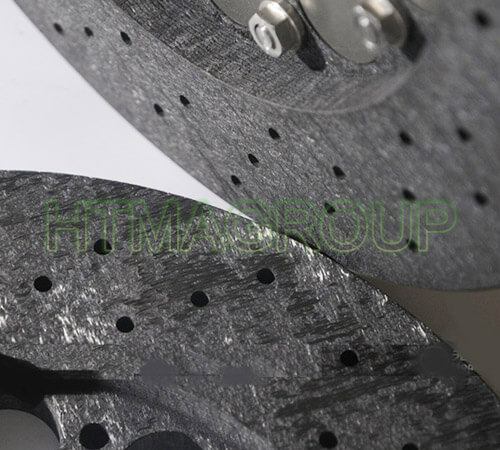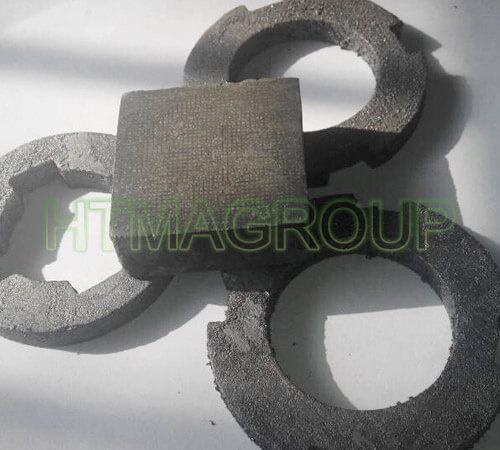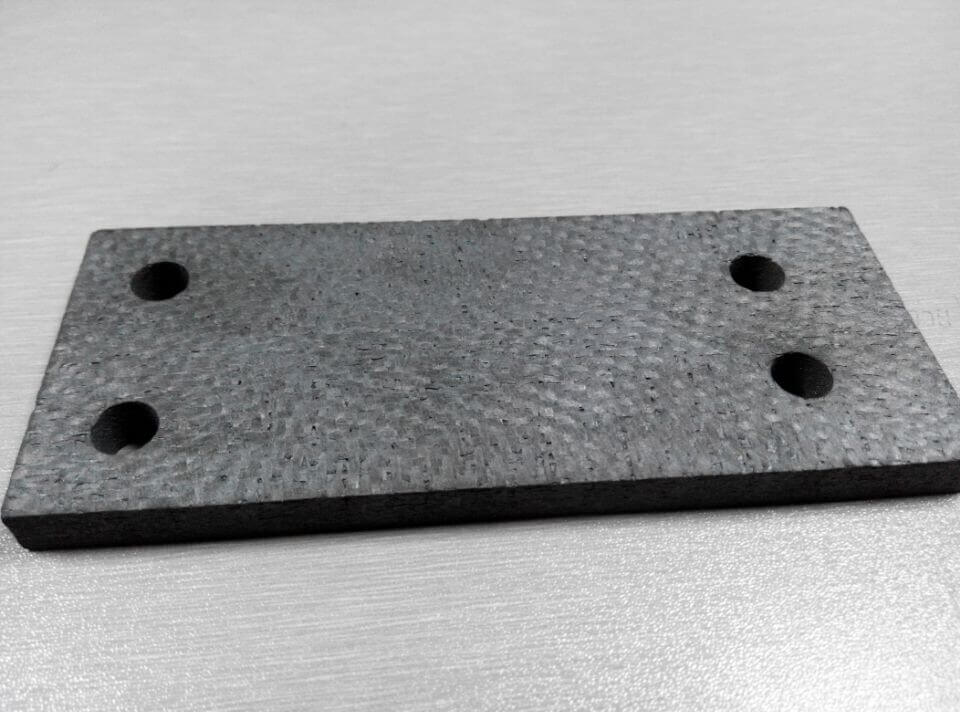1. CMC material introduction
Ceramic matrix composites (CMC) are a type of composite material that is composited with ceramics as a matrix and various fibers.
Ceramic matrix composites refer to the introduction of reinforcing materials into the ceramic matrix to form a composite

carbon ceramic composite
material with the introduced reinforcing material as the dispersed phase and the ceramic matrix as the continuous phase. It has the characteristics of high temperature resistance, wear resistance, high temperature creep resistance, low thermal conductivity, low thermal expansion coefficient, chemical corrosion resistance, high strength, high hardness and wave penetration, and is widely used in many fields such as aerospace. Ceramic matrix composites can be divided into two categories according to the continuity of the reinforcement: continuously reinforced composites and discontinuously reinforced composites. Ceramic matrix composites can greatly improve the reliability and consistency of materials while maintaining the excellent performance of a single ceramic material such as high temperature resistance, high strength, and low density. Tubes, missile radomes, space shuttle nose cones, aircraft brake discs, and high-end automobile brake discs have become an important branch of the field of composite materials.
Continuous fiber-reinforced ceramic matrix composites are the most outstanding type of materials in ceramic matrix

carbon ceramic composite C/SiC
composites. It is a high-performance composite material formed by implanting high-temperature-resistant continuous ceramic fibers into a ceramic matrix. It has high strength and high toughness. In particular, it has a non-catastrophic fracture mode different from that of a single ceramic, which has attracted great attention from researchers all over the world. With the advancement of fiber preparation technology and other related technologies, people have gradually developed effective methods for preparing such materials, making the preparation technology of fiber-reinforced ceramic matrix composites increasingly mature. Continuous fiber reinforced ceramic matrix composites have been widely used in aerospace, national defense and other fields.
2. Overview of Ceramic Matrix Composites——Advantages
Lightweight. The ceramic matrix composite material has a low density (only 1/3~1/4 of the superalloy), and can be used in components such as combustion chambers, regulating plates/sealing plates, and can directly reduce the mass by about 50%.
High temperature resistance. The working temperature of ceramic matrix composites is as high as 1650°C, which can simplify or even eliminate the cooling structure, optimize the engine structure, and increase the working temperature of the engine. Under the condition of no cooling structure, it can be used for a long time at 1200°C.
High stability. Ceramic matrix composites can maintain high stability in high temperature environments, even in aerobic environments, which reduces the development and application costs of thermal protective coatings.
Excellent mechanical properties. Through the optimization of the preparation process, especially the composition and structure design of the interface layer, the mechanical properties of ceramic matrix composites have been qualitatively improved compared with single-phase ceramics.
3. Comparison of preparation processes of ceramic matrix composites

C-SIC
Chemical Vapor Infiltration (CVI)
During the preparation process, the fiber damage is small, the prepared ceramic matrix has high purity and complete crystal form, and the mechanical properties of the composite material are high.
The manufacturing cycle is long, the cost is high, and the prepared composite material has high porosity. In general, it is carried out in conjunction with other methods.
Liquid silicon infiltration (LSI)
First, carbon fiber is woven into a three-dimensional fabric (hereinafter referred to as carbon fiber preform); a layer of simple silicon with a thickness of 0.1-2 μm is deposited on the carbon fiber preform by vapor deposition technology; phenolic resin, carbon black, ethanol, ultrafine silicon carbide Powder, polyvinylpyrrolidone and tetramethylammonium hydroxide are prepared in proportion to make a mixed slurry; the slurry is pressurized and impregnated into the above-mentioned carbon fiber prefabricated body in a vacuum environment to obtain a composite material green body; the above-mentioned green body is heated and solidified; The cured green body is placed in a vacuum furnace for high-temperature siliconization reaction to obtain a high-density, high-performance carbon-silicon carbide ceramic composite material.
This kind of preparation method has a short cycle and low cost. Generally, CVI should be combined first, and then LSI technology.
Polymer Infiltration and Pyrolysis process, PIP
Single-phase or multi-phase ceramics with controllable composition and structure can be prepared through the design of precursor components; the pyrolysis temperature is low, which reduces the damage to fibers during heat treatment; it can achieve near-net shape, reduce post-processing costs, and can prepare complex shapes large components.
The pyrolysis process of the polymer precursor is accompanied by a large volume shrinkage, which causes certain damage to the fiber; the ceramic yield in a single cycle is low, and multiple cycles of impregnation and cracking are required, and the manufacturing cycle is long; the porosity of the prepared ceramic matrix composite is relatively low. high.
Melt infiltration process
Reactive Melt Infiltration, RMI
Being able to prepare a dense and basically defect-free matrix through one-shot molding with less variation in structural dimensions between preforms and components is considered to be an effective way to prepare near-net-shape components with complex shapes quickly and at low cost.
During the melt infiltration process, the metal reacts with oxygen to form a dense oxide film, which hinders the further reaction of the metal that has penetrated into the composite material and remains inside the composite material.
4. Market Analysis of Ceramic Matrix Composites—Global Application Market
Aerospace is the largest market segment for ceramic matrix composites, accounting for about 43% of the total.
Ceramic matrix composites are well suited for manufacturing aircraft components due to their excellent properties such as high temperature stability, thermal shock resistance, dynamic load resistance, greater flexibility, etc.
The application of ceramic matrix composites in aircraft parts includes nose covers, rudders, fins, exhaust nozzles, leading edges, body flaps, gas turbine engines, panels and other engine parts.
5. Wide application of ceramic matrix composites in various fields:
Application in braking systems: C/C-SiC (LSI) composites are used in braking systems due to their low density, good wear resistance, constant and stable friction coefficient, thermal shock resistance, and oxidation resistance. . This kind of brake disc is light in weight, high in temperature resistance, and its specific heat capacity is 2.5 times higher than that of steel; compared with metal brake systems, it can save 40% of the structural weight. The service life of the carbon brake disc is 5-7 times that of the metal base, the braking torque is stable, and the noise is small when braking. The carbon brake disc of C/C-SiC composite material has been practically applied.
Application in heating elements: Compared with graphite heating elements with low strength, brittleness, and difficulty in processing and transportation, C/C composite materials have the advantages of high strength, good toughness, high temperature resistance, reduced heating element volume, and enlarged work area.
Applications in the aerospace field: C/C-SiC (PIP), SiCf/SiC, C/C-ZrC, have become a new generation of high-temperature resistant materials for aero-engines. The high-temperature components of an aero-engine mainly include combustion chambers, high/low pressure turbines and nozzles, among which the high/low pressure turbine components mainly include guide vanes, rotor blades and turbine outer rings. In the past, these components were mainly made of high-temperature alloys, and their temperature resistance limit was maintained at about 1100°C, but now the application of ceramic matrix composites increases the temperature resistance of engine components to 1200-1350°C, and the component quality of ceramic matrix composites is usually 1/4 to 1/3 of the mass of the superalloy not only realizes the fuel economy, but also improves the fuel economy.
The main preparation processes of C/C-SiC(PIP) composites include chemical vapor infiltration (CVI) process, polymer impregnation cracking (PIP),
The main preparation processes of C/C-ZrC composites include chemical vapor infiltration (CVI) process, melt infiltration process
Reactive Melt Infiltration, RMI
The main preparation processes of SiCf/SiC composites include chemical vapor infiltration (CVI) process, polymer impregnation pyrolysis (PIP) process and molten silicon infiltration (MI) process. Due to immature braiding technology, this kind of product is rarely produced and applied on a large scale.
Ceramic matrix composites are key thermal protection materials for the safe flight of hypersonic vehicles. The flight speed of a hypersonic vehicle is greater than or equal to 5 times the speed of sound. Such a high-speed flight must ensure that the key structural components of the vehicle withstand severe air friction and the impact of thermal airflows as high as 2000-3000 °C without being damaged. Because fiber reinforced ceramic matrix composites have the advantages of excellent high temperature performance, high toughness, high specific strength, high specific modulus and good thermal stability, they can effectively overcome the sensitivity to cracks and thermal shocks, and can be used in thermal protection for repeated use. The field also has important applications and a wide range of markets. At present, ceramic matrix composite heat insulation materials have developed from a single material to a new type of thermal protection system combining materials and structures, from the traditional separate design of heat protection, heat insulation, and load bearing to the integration of heat protection, heat insulation, and load bearing. development in the lightweight direction.
At present, the ceramic matrix composite materials with high application demand in the market are mainly carbon fiber reinforced silicon carbide ceramic matrix (Cf/SiC) composite materials. In the future, China’s ceramic composite material market has great potential for development. CFCCARBON is a company specializing in the production of Cf/SiC and C/C composite materials. Its products are exported to various countries around the world, and it has been working hard to create low-price, high-quality products.
6. For the material specifications of various processes, please refer to the attached pdf files below:
C-SiC(LSI)-friction material-CFCCARBON-2023
C-SiC (PIP)-ablation material-CFCCARBON-2023
CC-ZrC(RMI)-ablation material-CFCCARBON-2023
SiCf-SiC-engine blade-CFCCARBON-2023
Related knowledge:
Carbon Carbon Composite | C/C composite material
Carbon ceramic composite | C/SiC material and parts
Carbon fiber reinforced silicon carbide composites (C/SiC, C/C-SiC)-(1)
C/C-ZrC Composite | Microstructure and Mechanical Properties